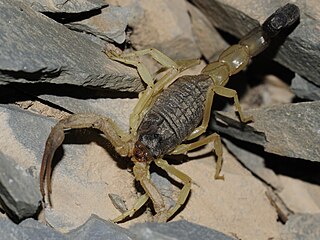
Hottentotta is a genus of scorpions of the family Buthidae. It is distributed widely across Africa, except for most of the Sahara desert. Species in the genus also occur in the Middle East, the Arabian Peninsula, southeastern Turkey, Iraq, Iran, Afghanistan, Pakistan, India, Nepal, Cape Verde Islands, and Sri Lanka (introduced).

Hottentotta tamulus, the Indian red scorpion, also known as the eastern Indian scorpion, is a species of scorpion of the family Buthidae. It occurs in most of India, eastern Pakistan and the eastern lowlands of Nepal, and recently from Sri Lanka.

Isometrus maculatus, commonly as the lesser brown scorpion, is a species of scorpion in the family Buthidae. Its distribution is pantropical; it is an introduced species in Hawaii.
Reddyanus basilicus is a species of scorpion in the family Buthidae.
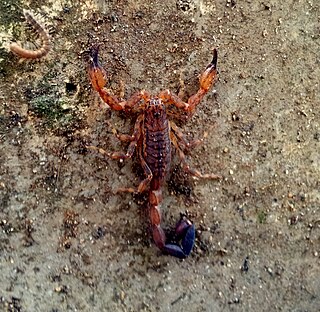
Reddyanus besucheti is a species of scorpion in the family Buthidae endemic to Sri Lanka.
Reddyanus problematicus, previously known as Isometrus problematicus, is a species of scorpion in the family Buthidae. Found in India, the species exhibits distinct characteristics. In females, the total body length measures approximately 22 millimeters (mm). The pedipalps, legs, and segments of the metasoma display a coloration ranging from yellow to reddish-brown, accentuated by black spots.
Reddyanus loebli is a species of scorpion in the family Buthidae.
Mesobuthus is an Asian genus of scorpions in the family Buthidae.

Charmus laneaus is a species of non-venomous scorpion in the family Buthidae endemic to Sri Lanka.
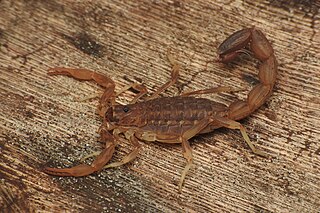
Lychas srilankensis is a species of scorpion in the family Buthidae. It is endemic to Sri Lanka.
Srilankametrus gravimanus is a species of scorpion belonging to the family Scorpionidae. It is native to India and Sri Lanka.

Leiurus abdullahbayrami is a species of scorpion in the family Buthidae. Its venom is highly toxic to humans, but can be used in medical development.
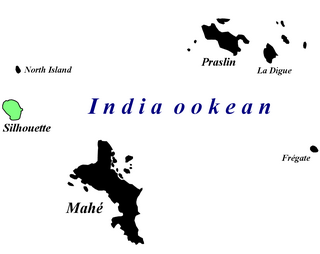
Afrolychas braueri, commonly known as the Seychelles forest scorpion, is a species of scorpion in the family Buthidae. It is currently thought to survive only on Silhouette Island, Seychelles, although the species was historically found on two additional Seychellois islands. This scorpion lives in leaf litter in forests that are largely unaffected by invasive plant species. It is a small yellowish-brown scorpion with three prominent keels on the dorsal surface of its mesosoma, which distinguishes it from other scorpions. While not much is known about the Seychelles forest scorpion's ecology due to the paucity of sightings, it is known to rely solely on its venom to capture its prey and defend its young. Its venom is not dangerous to humans.
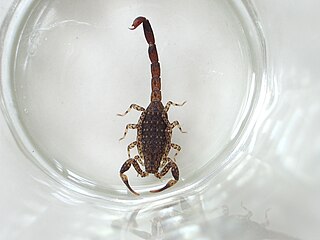
Lychas is a genus of scorpions belonging to the family Buthidae. It is one of the most widespread genus of the scorpions, where the species are found throughout in Africa and Seychelles, and in the Oriental region from India to Melanesia.
Charmus saradieli is a species of non-venomous scorpion in the family Buthidae endemic to Sri Lanka.

Reddyanus is a genus of buthid scorpions native to Oriental region from India, Sri Lanka, China: Tibet, to Melanesia. The genus was previously described as a subgenus of Isometrus.
Reddyanus ceylonensis is a species of scorpion in the family Buthidae endemic to Sri Lanka.
Reddyanus jayarathnei is a species of scorpion in the family Buthidae endemic to Sri Lanka.
Reddyanus ranawanai is a species of scorpion in the family Buthidae endemic to Sri Lanka.

Hemiscorpius lepturus is a species of scorpion in the family Hemiscorpiidae. It is found in deserts of the Middle East, especially in southern Iraq and Iran, where it is sometimes referred to as the "Gadim scorpion". These scorpions have long, thin tails and wide bodies and grow to 8 cm (3.1 in) in males and 5.5 cm (2.2 in) in females, allowing them to live in tight rock crevices. They are fairly solitary creatures. H. lepturus has mainly been studied to discover the components and effects of its venom, which is highly lethal and is responsible for most deaths due to scorpion sting in the Iran area. H. lepturus is the only scorpion not in the family Buthidae that is potentially lethal to humans; the Buthidae family is the largest and most abundant family of scorpions, containing many highly venomous species.










